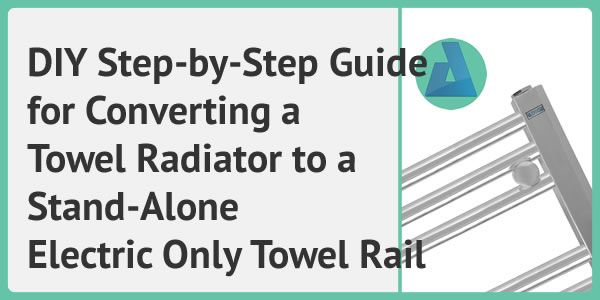Towel radiators are an excellent addition to any bathroom or living space, providing warmth and a sense of luxury to your daily routine. While many towel radiators operate on central heating systems, it's also possible to convert them to a standalone electric-only type. If you're looking to make this switch, here's what you need to know. A Comprehensive yet simple 8 steps to follow for an electric towel rail.
Check Compatibility:
Almost all our bathroom towel radiators can be used as electric only including our Horizontal Towel Radiators, it's essential to note that not all towel radiators are compatible with electric-only conversion. Before you start, ensure that your radiator is one and you have an empty space/allowance at the bottom of the radiator. Depending on the electric element model, you will need approx. 200mm space from floor level to the bottom of the radiator. This will allow for the inclusion of an electric element, which is required to heat the water inside and generate heat.
Decide on Heating Element Type, Wattage & Finish:
Once you've confirmed your radiator's compatibility, the next step is to purchase an electric heating element and a blanking plug. All elements are designed to fit standard British BSP sized towel radiators, ranging from 200 mm to 1600 mm in length. The wattage required will vary, depending on the size of your radiator, amount of water intake and the intended room use. You will also have the option of a basic/standard heating element or a more sophisticated thermostatic towel rail element one where you can control the heat output, run it on timer, use boosters etc.
Check the Required Parts & Tools:
As well as the main parts, you will need the correct amount of de-ionized water and a radiator inhibitor. These will be mixed as per inhibitor’s recommended dilution/mix level and used to fill the radiator manually during installation. You will also need all the usual tools, a funnel and a bucket for the mix. Before you begin, ensure all items, parts, tools below are in hand;
- Towel Radiator
- Electric Heating Element
- A Blanking Plug (2 if your towel radiator did not come with one and it has 4 inlet points)
- De-ionized Water & Inhibitor
- Funnel, Bucket, Cloth or Old Towels
- Basic and Common Tools to Complete the Job
Screwdriver set, drill, spirit level, 8mm allen key, spanner, plyers etc. and a cup of tea.
Step-by-Step Installation:
When it comes to installation, you will need to take your time and follow these steps in the same order listed below. Missing one, or not completing each step properly may result poor performance from your electrically heated towel radiator and you may need to remove the radiator off the wall, drain it and do it all again from step 1.
- Turn the radiator upside down and decide where the element will be. i.e., left or right and install the element to your selection and make a note (say right). While all our heating elements come with a rubber O ring, it is still recommended to use a generous amount of PTFE tape to ensure no leaks from joints.
- Install the blanking plug purchased to the other side (left). Again, use plenty PTFE tape to ensure no leaks from joints.
- Turn the radiator correct way up and fill it up manually using the funnel with de-ionized (deionised) water and inhibitor mix. All our radiators do have their water intake levels listed on product details page.
Tip: You should fill the radiator as slowly as possible avoiding sudden gush of water blocking the air around or inside the tubes. It is also advisable to tilt the radiator left and right a few times while filling to make sure water mix goes through and fill ALL the bars.
Important: Make sure that the radiator is NOT filled all the way to the top by leaving 1 or 2 inches of space for water to expand when heated. - Once filled, insert and secure the blanking plug (supplied with the radiator) to the same side of the radiator as the element. i.e., if element installed on bottom right, install the blanking plug on top right.
- Affix the towel rail on to the wall using wall brackets supplied while keeping it level to avoid spillage.
- Wire the heating element to your fused spur on the wall. Put a few towels over the radiator and turn the element ON to its maximum power.
Tip: ** please note that at this stage the top left inlet point is still open to air **
As the water heats up, it will expand and if the radiator is filled too much earlier, some water may spill out. (Have some old towels nearby to soak up any spillage) - Once the towel rail recaches its max temperature, insert and screw the bleed valve to the top left inlet point.
Important: ** it is important to install the element and the bleed valve on opposite sides ** (i.e., element on bottom right would mean bleed valve on top left) - Check that all inlet points secure and air-tight and there are no leaks or hissing. Wipe clean any damp or spillage and enjoy your stand-alone Electric Towel Rail many years to come.
Depending on the electric element you've purchased, there will be different installation instructions, but most require you to wire them into a fused spur either inside or outside the bathroom. If you opt in for a thermostatic one, you can try and use various settings till you find the best settings suits you most and works well with your daily routine.
Inconclusion, converting your towel radiator to an electric-only type is a straightforward process. However, if you're not confident working with electric appliances, it's best to consult a professional plumber and an electrician to the wiring. That said, this conversion will provide you with efficient and effective heating, allowing you to enjoy the luxurious warmth of your heated towel radiator all year round.


